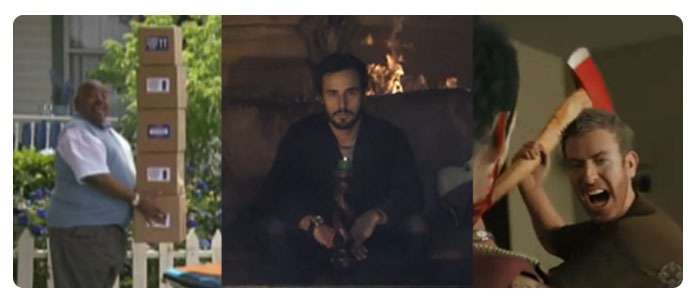For the first Shot Ideas post I thought I’d go back to one of the oldest ideas in the book. The first thing any kid with an editing system will do is start messing around with speed and timing. Reversing footage is simple as it gets, but that doesn’t mean that it can’t be a powerful tool to get real emotion and narrative. Sure you can regurgitate food or sucks things off the ground, but I think there is a more to this technique
than meets the eye.

HISTORY:
Demolition of a Wall (1896)
The first film I can find that contains reverse motion is this silent film “Demolition of a Wall” (aka Démolition d’un mur) by Louis Lumier. The story goes that the famous Lumiere brothers liked to screen this film for audiences and then suddenly reverse the footage at the mid point, much to the amusement and bafflement of the audience. It’s hard to imagine what it would be like a hundred years ago to see a wall fall the pieces and then magically get back up in one piece.
The Lumiere brothers are also well know for “Arrival of a Train at a Station“, which is featured heavily in Martin Scorsese’s Hugo.
EXAMPLES:
Dead Island
One of the hands down best modern examples of using reverse motion is this trailer for the video game Dead Island. Directed by Stuart Aitken at Axis Animation, this film is a perfect display of how telling a narrative in reverse can suck you right in. Starting with the image of a dead girl and reversing the story back to it’s origin begs the audience to see how it all began. My favourite part is how Stuart really elevates the film by cross cutting the the opening with the forward motion of the beginning.
Just Starting
This experimental short falls more into the “lets do crazy stuff and rewind it” camp, but it does it with style. Directed by the french group Capsus films, it’s best moments are the rewinding fireworks and fire. While this is definitely more experiential then Dead Island, it still does have the same narrative effect of asking the audience “what is the source of this mayhem”? I think I only like this video because of the last shot of Pandora’s box closing (or opening). It gives colours everything that came before with a lot more moral weight. It leaves me not wanting to open strange smoking boxes.
There is also a making of here.
Time Upon a Once
In doing research for this post I realized I too had a film that use a lot of reverse motion to tell narrative. It may come off as a shameless plug, but I think it’s a good example of how you can build a story around an interesting technique. Here I use the idea of reverse and forward motion as a pretty heavy handed metaphor for xenophobia. It’s a simple idea but I try and do something new with it.
Tik Tok
The film Tik Tok by director Ien Chi uses reverse motion narratively in the same way as Dead Island. I asked Ien about why he decided to film his short this way, and what he learned from using this technique.
Well, I think the unique thing about “Tick Tock” is that it’s one shot while it’s backwards; there’s a fluidity there that I had never seen before in a short – so it was something I wanted to try. In terms of why I wanted to tell the story that way? Well, to be honest, the essential story of “Tick Tock” itself is pretty cliche – I just thought the backwards aspect would be a new way to tell the story so that we follow the character backwards to what could possibly have led him to do what he did, instead of a forward going story that would have been just another boring take on the “what would you do if you were going to die soon?” idea. More of a mystery revealing itself rather than a predictable plot.
Overall I’d say the film was a tremendous learning experience because it turned out so vastly different from what I originally envisioned (I guess that happens with all films though). It was certainly slightly easier to edit because of no cutting in post; we just took our best take and flew with it. I had no idea how the backwards thing would all work out; but I think why it worked so well is precisely because we had no clue what the hell we were doing. It was something new, and I think something genuinely new attracts attention by virtue of its “new-ness”. Take that with a grain of salt though – maybe we just got lucky


Love the new site, Zach!
My favorite example of reverse motion to tell a story and hook an audience (besides Time Upon a Once, of course) is the opening of Memento. I remember seeing this for the first time and being totally gobsmacked.
The movie is about fading memory, and a character who digs into the opaque past to reveal a mystery, and the whole film is told in reverse narratively. So the opening few shots, which unfold in reverse motion, are the perfect distillation of the movie as a whole, as well as the perfect tool for hooking the audience into the mystery.
I can’t imagine the film opening any other way besides that slowly fading polaroid picture, which soon gets put back into the camera, untaken… just as the character is forgetting what he’s seen. I also love that it’s not obviously reverse motion at first, that it takes a minute to figure out what’s going on…. it brings you into the disorienting world of the character. Truly brilliant.
Here’s a writeup about it from critic Andrew Davies.